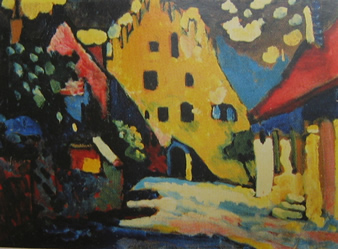Note: this entry is now archived and has been removed from the main database
« Tous à Cuves | Back to "More Archives" | In a spin »
Friday September 22, 2006
Path to Abstraction
Today we went to Tate Modern to see "Wassily Kandinsky's intriguing journey from figurative landscape painter to modernist master, as he strove to develop a radically abstract language". That is from this:

to this:

One of the intermediate pictures was most revealing to me, (after having had it explained by the audio guide), in that although at first take it may look like an abstract picture, every element within it is a recognisable feature (people and animals, or plants); it is not at all an abstract. During this earlier part of his life's work that the exhibition covers, he evolved 3 types of work: Observations (taken from nature), Improvisations (expressing a mood or emotion), and Compositions (large scale abstract works, of which only 7 survive). The latter 2 descriptions emphasise his correlation of music and visual art.
The "audio guide" was in fact a multimedia iPod thing which I would strongly recommend; they are able to describe the pictures, provide musical references (Kandinsky was very interested in the new musical theories of Schoenberg and the link between music and colour - synaesthesia - he saw art providing an alternative music for the senses), and show other influential artists work. His work followed the changes in his residence, which in turn were stimulated by wars, and politics. He lived in Germany until the outbreak of war in 1914, whereupon he moved back to Russia; he then returned to Germany (to join the Bauhaus) after the revolution, and finally moved to Paris in 1933 when the Bauhaus closed - it was not right wing enough for the fascist government of the time.
The other amusing thing for the uninitiated is that the abstracts always look like a load of wild uncontrolled splodges of paint thrown at the picture; however, all his abstracts were very carefully planned pieces, evolving from many sketches and preliminary paintings. These plans and the paintings themselves were on display.
Posted by Christina at 8:52 PM. Category: Days Out
Comments
I'm going to have to show this page to Adam because apparently this month in Kindergarten they have been studying the work of Kandinsky (!). He came home with his own piece of abstract art which he explained was about feelings.
Personally I would prefer that they were teaching him to read...but that's the modern curriculum for you.
Posted by: Alison on September 26, 2006 4:44 PM

